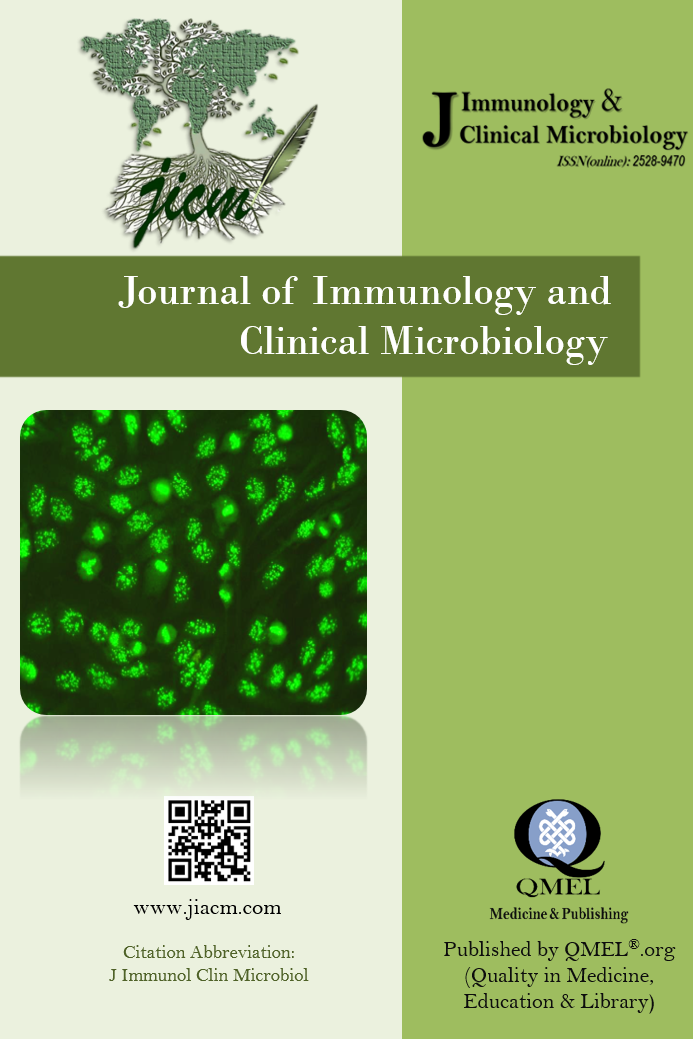COVID-19 Hastalarında İmmunokromatografik Antikor Testi Sonuçları
COVID-19, immunokromatografi, PCR, antikor
Evaluation of Immunochromatographic Antibody Test Results in Patients with Prediagnosis of COVID-19
Covid-19, immunokromatografi, PCR, antikor,
___
- 1. The epidemiology and pathogenesis of coronavirus disease (COVID-19) outbreak: Rothan HA et al (J Autoimmun 2020 May;109:102433. doi: 10.1016/j.jaut.2020.102433) 2. Molecular immune pathogenesis and diagnosis of COVID-19: Li X, Geng M, Peng Y, Meng L, Lu S. (J Pharm Anal. 2020 Mar 5. doi: 10.1016/j.jpha.2020.03.001)
- 3. Antbody responses to SARS-CoV-2 n patents of novel coronavrus dsease 2019 Zhao et al. (Cln Infect Ds 28 March 2020; do: 10.1093/cd/caa344)
- 4. Serologcal mmunochromatographc approach n dagnoss wth SARSCOV-2 nfected COVID-19 patents Pan Y et al. (J Infect 2020 Apr 10. p:S0163-4453(20)30175-4; do: 10.1016/j.jnf.2020.03.051)
- 5. The Laboratory Dagnoss of COVID-19 Infecton: Current Issues and Challenges Tang YW et al. (J Cln Mcrobol 3 Aprl 2020; do:10.1128/JCM.00512-20)
- 6. Report from the Amercan Socety for Mcrobology COVID-19 Internatonal Summt, 23 March 2020: Value of Dagnostc Testng for SARS–CoV-2/COVID-19 Patel R et al. (mBo 2020 Mar-Apr; 11(2): e00722-20; do: 10.1128/mBo.00722-20)
- 7. Hong K.H, Lee S.V, Kim TS, Huh HJ, Lee J,Yeon Kim S, et al. Guidelines for Laboratory Diagnosis of Coronavirus Disease 2019 (COVID-19) in Korea. Annals of Laboratory Medicine.2020; 40(5):351–60.
- 8. Zitek T. The Appropriate Use of Testing for COVID-19. Western Journal of Emergency Medicine 2020; 21(3):470–72.
- 9. Conklin, S. E., Martin, K., Manabe, Y. C., Schmidt, H. A., Miller, J., Keruly, M., Klock, E., Kirby, C. S., Baker, O. R., Fernandez, R. E., Eby, Y. J., Hardick, J., Shaw-Saliba, K., Rothman, R. E., Caturegli, P. P., Redd, A. D., Tobian, A. A. R., Bloch, E. M., Benjamin Larman, H., … Laeyendecker, O. (2021). Evaluation of serological SARS-CoV-2 lateral flow assays for rapid point-of-care testing. Journal of Clinical Microbiology, 59(2), 1–10. https://doi.org/10.1128/JCM.02020-20
- 10. Diagnostic performance of COVID-19 serology assays: Z Zainol Rashid et al. Malays J Pathol.2020 Apr;42(1):13-21.
- 11. Pan, Y., Li, X., Yang, G., et al (2020). Serological immunochromatographic approach in diagnosis with SARS-CoV-2 infected COVID19 patients. J Infect, doi:10.1016/j.jinf.2020.03.051
- 12. Lechien , J.R., et al., Olfactory and gustatory dysfunctions as a clinical presentation of mild-to-moderate forms of the coronavirus disease (COVID-19): a multicenter European study. Eur Arch Otorhinolaryngol, 2020.
- 13. Zhao, W., et al., Relation Between Chest CT Findings and Clinical Conditions of Coronavirus Disease (COVID-19) Pneumonia: A Multicenter Study. American Journal of Roentgenology, 2020: p. 1-6.
- 14. Parasher, A., Saini, V., Saini, A., Barik, R. R., Aggarwal, A., & Khan, J. (2020). A study of the association of leukopenia with disease severity and mortality in patients diagnosed with COVID-19. International Journal of Advances in Medicine, 7(11), 1721. https://doi.org/10.18203/2349-3933.ijam20204526
- 15. Luo X, Zhou W, Xiaojie Y et al (2020). Prognostic value of C-reactive protein in patients with COVID-19. medRxiv, doi: 10.1101/2020.03.21.20040360.
- 16. Lippi G, Plebani M (2020). Procalcitonin in patients with severe coronavirus disease 2019 (COVID-19): a metaanalysis. Clin Chim Acta, 505:190-191. doi: 10.1016/j.cca.2020.03.004.
- 17. Ozen, M., Yilmaz, A., Cakmak, V., Beyoglu, R., Oskay, A., Seyit, M., & Senol, H. (2021). D-Dimer as a potential biomarker for disease severity in COVID-19. American Journal of Emergency Medicine, 40, 55–59. https://doi.org/10.1016/j.ajem.2020.12.023
- 18. Patel R, Babady E, Theel E, Storch G, Pinsky B, George K, et al. Report from the American Society for Microbiology COVID-19 COVID-19. MBio. 2020;11(2):1-5
- 19. Chakraborty, D., Kumar, S., Chandrasekaran, N., & Mukherjee, A. (2020). Viral Diagnostics and Preventive Techniques in the Era of COVID-19: Role of Nanoparticles. Frontiers in Nanotechnology, 2(October), 1–7. https://doi.org/10.3389/fnano.2020.588795
- 20. Zhang W, Du RH, Li B, et al. Molecular and serological investigation of 2019-nCoV infected patients: implication of multiple shedding routes. Emerg Microbes Infect. 2020;9(1):386-9
- 21. Wu, J., Tseng, W., Lin, C., Lee, T., & Chung, M. (2020). Since January 2020 Elsevier has created a COVID-19 resource centre with free information in English and Mandarin on the novel coronavirus COVID- 19. The COVID-19 resource centre is hosted on Elsevier Connect, the company ’ s public news and information. Journal of Infection, 81(January), 435–442.
- Yayın Aralığı: Yılda 4 Sayı
- Başlangıç: 2016
- Yayıncı: Erkan YULA
Kısa Barsak Sendromunda Mikrobiyota ve Pre-Probiyotikler
Eftal GEÇGİL DEMİR, Fatma Bengü KUYULU BOZDOĞAN, Aybala TAZEOĞLU
Evaluation on the correlation between gender and drug allergy agent and its incidence frequency
İzzet FİDANCI, Mert SATILMIŞ, Duygu AYHAN BAŞER, Hilal AKSOY, Duygu YENGİL TACİ, Mustafa CANKURTARAN
Peripheral Facial Paralysis After COVID-19 Vaccination
COVID-19 Hastalarında İmmunokromatografik Antikor Testi Sonuçları
Ahmet DOĞAN, Hatun ÖZTÜRK ÇERİK, Atila GÜRGEN, Aykut ÖZTURAN
Zeynep TANRIVERDİ, Onur YİĞİTASLAN, Salih Atakan NEMLİ, Süreyya GÜL YURTSEVER, Esra BASKURT, Hatice TÜRE, Mehmet ÇELEBİSOY
The effects of balneotherapy on depression and anxiety scale scores in patients with osteoarthritis
